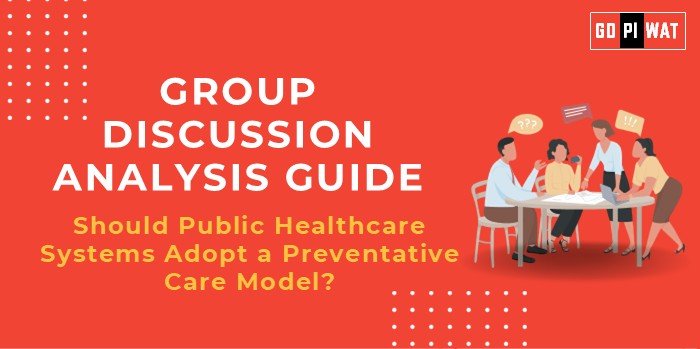📋 Group Discussion Analysis Guide
🌐 Should Public Healthcare Systems Adopt a Preventative Care Model?
💡 Introduction to Preventative Care
Opening Context: Globally, healthcare costs are soaring, driven by lifestyle-related diseases and aging populations. The need for cost-efficient, sustainable solutions has spotlighted the preventative care model.
Topic Background: Preventative care emphasizes proactive measures like vaccinations, screenings, and healthy lifestyle promotion to reduce disease burden. While many countries invest heavily in curative models, nations like Canada and Finland highlight the benefits of a preventative focus.
📊 Quick Facts and Key Statistics
- Global Healthcare Spending: $8.3 trillion in 2021, with 80% allocated to treatment of preventable conditions (WHO, 2022).
- Lifestyle Diseases: Account for 70% of deaths globally (CDC, 2023).
- Economic Impact of Prevention: Every $1 invested in prevention yields $4 in economic returns (Lancet Study, 2023).
- Public Satisfaction: Preventative programs in Sweden and Norway led to a 40% rise in citizen satisfaction with healthcare.
🏥 Stakeholders and Their Roles
- Governments: Policy creation, funding, and program implementation.
- Healthcare Providers: Delivering education, screenings, and vaccinations.
- Private Sector: Developing innovative technologies for early detection.
- Citizens: Adopting healthier lifestyles and participating in screenings.
- International Organizations: Providing guidelines and funding assistance (e.g., WHO).
✨ Achievements and Challenges
Achievements:
- Improved Lifespan: Finland’s prevention-focused model increased life expectancy by 4 years between 2000 and 2020.
- Cost Efficiency: The UK saved £5 billion annually through early cancer screenings.
- Disease Reduction: U.S. obesity rates dropped 12% in states with active prevention campaigns.
Challenges:
- Awareness Gap: Low health literacy, especially in rural areas.
- Funding Imbalance: Only 2-3% of healthcare budgets are typically allocated to prevention (OECD, 2023).
- Cultural Resistance: Hesitation in adopting lifestyle changes.
Global Comparisons:
- Success: Canada’s Preventative Health Task Force saved $6 billion over five years.
- Struggle: Developing nations face infrastructure and funding constraints.
Case Study:
Kerala, India – Low maternal and infant mortality due to extensive vaccination drives.
📚 Structured Arguments for Discussion
- Supporting Stance: “Preventative care reduces long-term healthcare costs while enhancing population health outcomes.”
- Opposing Stance: “In regions with limited resources, investing in curative care yields more immediate benefits.”
- Balanced Perspective: “A hybrid model can bridge the gap, emphasizing prevention without neglecting acute care needs.”
🎯 Effective Discussion Approaches
- Opening Approaches:
- “Did you know that 70% of global deaths are due to preventable diseases?”
- “Canada’s healthcare model proves prevention saves billions—should we emulate this approach?”
- Counter-Argument Handling:
“While curative care is vital, ignoring prevention perpetuates a costly and unsustainable cycle of illness.”
🔍 Strategic Analysis of Strengths and Weaknesses
- Strengths: Cost savings, improved population health, and global recognition.
- Weaknesses: Requires upfront investment and systemic reorganization.
- Opportunities: AI-driven early detection, policy incentives.
- Threats: Political resistance, cultural inertia.
📈 Connecting with B-School Applications
- Real-World Applications: Healthcare management, policy design, and financial planning projects.
- Sample Interview Questions:
- “How would you design a preventative care program for urban India?”
- “What role do private players have in scaling preventative healthcare?”
- Insights for B-School Students:
- Focus on cost-benefit analysis in healthcare.
- Evaluate AI’s role in scalable preventative measures.


